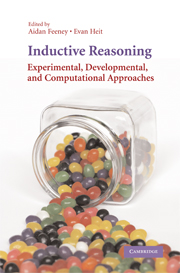Book contents
- Frontmatter
- Contents
- List of Figures
- List of Tables
- List of Contributors
- Preface
- 1 What Is Induction and Why Study It?
- 2 The Development of Inductive Reasoning
- 3 Interpreting Asymmetries of Projection in Children's Inductive Reasoning
- 4 Property Generalization as Causal Reasoning
- 5 Availability in Category-Based Induction
- 6 From Similarity to Chance
- 7 Theory-Based Bayesian Models of Inductive Reasoning
- 8 Use of Single or Multiple Categories in Category-Based Induction
- 9 Abductive Inference: From Philosophical Analysis to Neural Mechanisms
- 10 Mathematical Induction and Induction in Mathematics
- 11 Induction, Deduction, and Argument Strength in Human Reasoning and Argumentation
- 12 Individual Differences, Dual Processes, and Induction
- 13 Taxonomizing Induction
- Index
8 - Use of Single or Multiple Categories in Category-Based Induction
Published online by Cambridge University Press: 26 February 2010
- Frontmatter
- Contents
- List of Figures
- List of Tables
- List of Contributors
- Preface
- 1 What Is Induction and Why Study It?
- 2 The Development of Inductive Reasoning
- 3 Interpreting Asymmetries of Projection in Children's Inductive Reasoning
- 4 Property Generalization as Causal Reasoning
- 5 Availability in Category-Based Induction
- 6 From Similarity to Chance
- 7 Theory-Based Bayesian Models of Inductive Reasoning
- 8 Use of Single or Multiple Categories in Category-Based Induction
- 9 Abductive Inference: From Philosophical Analysis to Neural Mechanisms
- 10 Mathematical Induction and Induction in Mathematics
- 11 Induction, Deduction, and Argument Strength in Human Reasoning and Argumentation
- 12 Individual Differences, Dual Processes, and Induction
- 13 Taxonomizing Induction
- Index
Summary
Uncertainty is a basic fact of life. Despite uncertainty, people must make predictions about the world. Will the car you are considering buying be reliable? Will you like the food you order? When you see an animal in the woods, what should you do? One source of information that reduces uncertainty is category membership. Although all Toyota Camrys are not exactly the same, they are similar enough that you can predict with some confidence that the new Camry you are considering will be reliable. Kansas City style barbecue ribs are not identical, but they taste more similar to one another than they do to roast chicken or “tofu surprise.” Knowing the category of an entity therefore serves to reduce the uncertainty associated with it, and the category reduces uncertainty to the degree that the category members are uniform with respect to the prediction you want to make. This category-based induction is one of the main ways that categories are useful to us in everyday life.
Unfortunately, this reduction of uncertainty is limited by the uncertainty of category membership itself. If you go to the Toyota dealership and order a Camry, you can be close to 100% sure that your new car is going to be a Camry. But in many other situations, you cannot be 100% sure.
- Type
- Chapter
- Information
- Inductive ReasoningExperimental, Developmental, and Computational Approaches, pp. 205 - 225Publisher: Cambridge University PressPrint publication year: 2007
- 6
- Cited by



